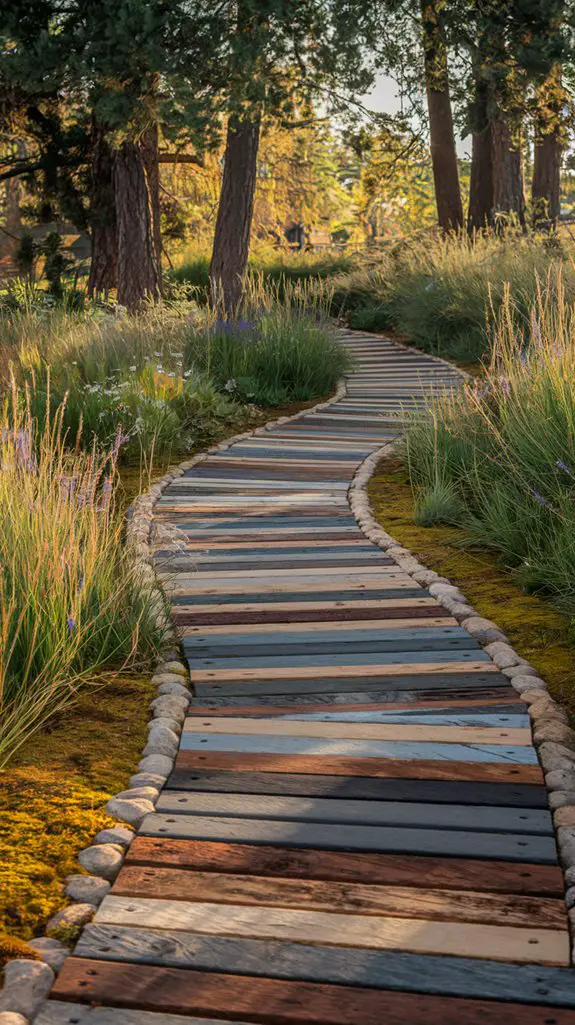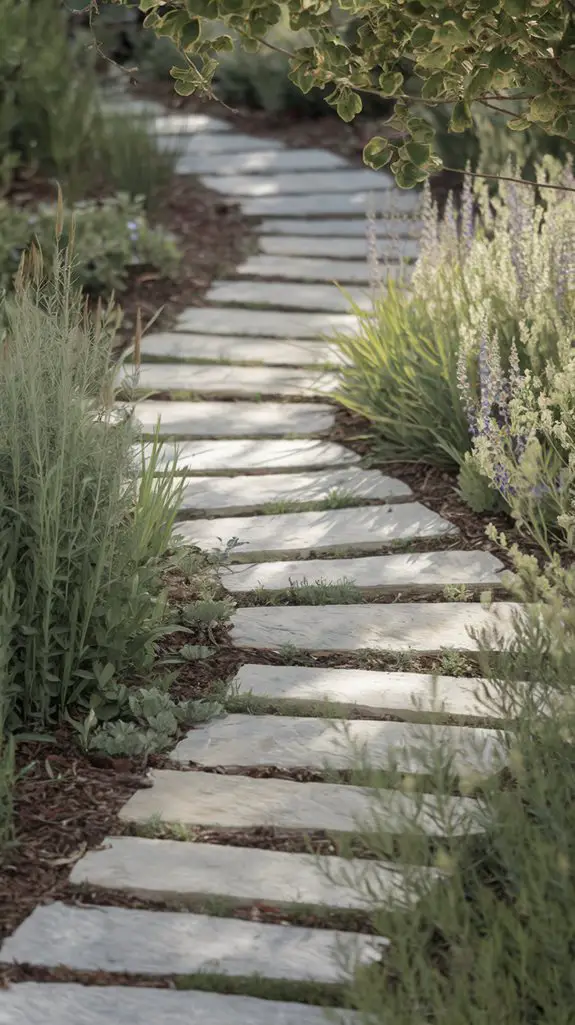Your garden’s pathways aren’t merely functional changes—they’re essential design elements that define your outdoor space’s character. When you choose rustic materials like weathered stone, gravel, or reclaimed wood, you’re making a commitment to both aesthetic harmony and environmental stewardship. These natural elements age gracefully, developing rich patinas that blend seamlessly with surrounding plantings while allowing proper drainage. The sustainable approach offers durability that modern alternatives can’t match, and the results speak volumes about your landscape values.
Natural Charm and Character of Rustic Garden Pathways
Rustic garden pathways evoke an innate connection to nature that manufactured alternatives simply can’t replicate.
These organically designed routes integrate seamlessly with your landscape’s existing topography, creating a visual harmony that respects the environment’s integrity.
You’ll find that materials like local stone, reclaimed wood, and decomposed granite weather gracefully over time, developing unique patinas that reflect your garden’s microclimate.
Unlike rigid, industrialized pathways, these rustic elements adapt to seasonal shifts—expanding, contracting, and settling naturally with freeze-thaw cycles and rainfall patterns.
The irregular textures and non-uniform surfaces provide essential ecological services too—improving drainage, reducing runoff, and creating microhabitats for beneficial organisms that enhance your garden’s biodiversity and resilience. Additionally, these pathways can complement charming water features to create a serene and inviting atmosphere in your backyard.
Cost-Effective Materials for Rustic Garden Walkways

Frugality need not compromise aesthetic integrity when constructing garden walkways with natural appeal. By selecting locally-sourced, repurposed, or renewable materials, you’ll create environmentally-responsible pathways while maintaining budget constraints.
Consider these cost-effective rustic options:
- Reclaimed brick or stone – Salvaged materials offer weathered textures and historical character while diverting construction waste from landfills.
- Mulch and wood chips – A renewable by-product of arboriculture that decomposes gradually, enriching soil structure while providing excellent drainage.
- Crushed stone or pea gravel – Requires minimal processing, creates permeable surfaces for water filtration, and costs substantially less than pre-fabricated pavers.
These materials not only reduce initial expenditure but also minimize maintenance costs through their inherent durability and adaptability to seasonal changes. Additionally, incorporating eco-friendly landscaping tips can further enhance the sustainability of your garden pathways.
Environmentally Friendly Pathway Solutions

While designing your garden pathways, prioritizing ecological sustainability yields benefits that extend far beyond aesthetic appeal.
Permeable materials like loose gravel, decomposed granite, and spaced flagstones allow rainwater to penetrate soil naturally, reducing runoff and replenishing groundwater supplies.
Consider reclaimed materials—salvaged bricks, repurposed timber, or stone collected from local sources—to minimize your carbon footprint.
These elements not only prevent construction waste but also infuse your garden with authentic character.
Native groundcover plants between stepping stones offer dual advantages: they filter rainwater and provide habitat for beneficial insects.
For binding agents, opt for natural alternatives like pine resin instead of cement-based products.
When illumination is necessary, install solar-powered lights that harness renewable energy without increasing electricity consumption.
Additionally, using eco-friendly options for garden pathways can enhance the overall sustainability of your landscape design.
Weather Resistance and Durability Advantages
Beyond ecological considerations, your rustic pathway’s longevity hinges on its ability to withstand seasonal challenges. Natural materials like stone, gravel, and hardwood develop protective patinas over time, actually strengthening with exposure to elements. Unlike manufactured alternatives requiring replacement every 5-7 years, properly installed rustic pathways often maintain integrity for decades.
- Permeable surfaces allow water drainage, preventing frost heave damage common in rigid concrete installations.
- Natural materials expand and contract with temperature fluctuations without cracking.
- Modular components (individual stones, timber sections) facilitate spot repairs rather than complete replacement.
These durability factors translate to lower lifetime maintenance costs despite potentially higher initial investment. Regular maintenance of raised garden beds can further enhance the longevity and effectiveness of your garden design.
Complementing Your Garden’s Aesthetic With Rustic Designs
When selecting pathway materials and layouts for your garden, the rustic aesthetic shouldn’t merely exist as an isolated feature but rather harmonize with your broader landscape vision.
Consider how pathways can echo existing elements—weathered wooden fences, stone retaining walls, or native plantings—to create visual coherence throughout your space.
Choose materials that complement your garden’s palette. Irregular flagstones pair beautifully with cottage gardens, while bark mulch pathways integrate seamlessly with woodland settings.
Reclaimed brick offers historical resonance for heritage properties, and crushed granite provides textural contrast against lush greenery. Adding stunning stone features can elevate the rustic charm of your pathways, further enhancing the overall aesthetic.
The most successful rustic pathways feel intentional yet organic, as though they’ve emerged naturally from the landscape.
DIY Installation Tips for Rustic Garden Paths
Creating rustic garden pathways yourself offers substantial benefits beyond aesthetic appeal—including cost savings and the satisfaction of personal craftsmanship.
When installing your path, begin with proper excavation to a depth of 4-6 inches, ensuring adequate drainage by incorporating a 2-inch layer of crushed gravel beneath your chosen materials.
- Select sustainable materials like reclaimed wood, locally sourced stone, or recycled brick to minimize environmental impact while maximizing authentic rustic character.
- Maintain gentle curves rather than straight lines, following natural contours of your landscape to create visual flow and reduce erosion concerns.
- Install sturdy edging using metal strips, pressure-treated lumber, or stone borders to prevent material migration and maintain clean pathway definition.
Always consider seasonal water flow patterns when positioning your pathway to avoid future drainage issues. Additionally, incorporating unique stone walkway designs can enhance the overall charm and functionality of your rustic paths.
Seasonal Maintenance and Long-Term Care
The enduring beauty of your rustic garden pathway depends on consistent seasonal maintenance and preventative care throughout the year.
Spring calls for debris removal and edge redefinition, while summer requires vigilance against encroaching vegetation that threatens material integrity.
In autumn, clear fallen leaves promptly to prevent decomposition that accelerates pathway deterioration.
Winter demands protective measures—apply eco-friendly sealants to wooden elements and monitor drainage patterns during freeze-thaw cycles.
Annually inspect for structural compromise: shifting stones, rotting timber, or eroded substrate.
Replace biodegradable materials like mulch or pine straw before complete decomposition occurs.
When repairing sections, match existing materials’ weathering patterns for aesthetic continuity.
Incorporating regular cleaning of water features into your maintenance routine can also enhance the overall appearance of your garden.
This systematic approach to seasonal maintenance guarantees your pathway remains not only visually compelling but structurally sound—extending its lifespan while preserving your garden’s rustic character.
Conclusion
As you stroll along your newly installed rustic pathway, you’re not merely traversing your garden—you’re participating in an ecological narrative. These permeable, weather-resilient routes minimize your carbon footprint while maximizing drainage efficacy. They’ll age gracefully, developing rich patinas that chronicle seasonal cycles. Your investment in reclaimed materials doesn’t just complement your landscape’s aesthetic integrity; it embodies sustainable design principles that honor both form and function.




